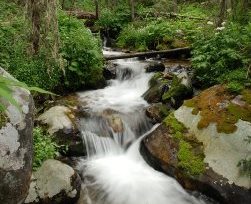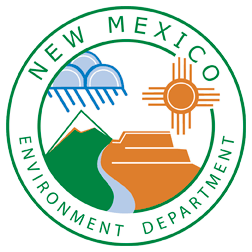As all New Mexicans know, water in our state is a very precious – and at times elusive – resource. Even with New Mexico’s wonderful diversity of ecosystems , the mostly desert landscape receives an average of 10 inches of precipitation annually…
Surface water (rivers, lakes and streams) in New Mexico originates as rain or melting snow, but over 95% of that water evaporates or is transpired by plants.Most of New Mexico’s fresh water is stored as groundwater in aquifers or confining layers below the land surface, where it occupies small open spaces between sand or gravel and small fractures in rock.
Water Topics Spotlight:
NMED is responsible for overseeing water infrastructure systems and water quality issues throughout the state.
NOTE: The state’s water resources in regards to water quantity, appropriation, and distribution of surface and ground waters are administered by the Office of the State Engineer.
NMED has many programs that focus on protecting the quality of our waters and assuring safe and effective infrastructure for delivering clean water to our communities. We coordinate much of our work with federal agencies, other state agencies, local governments, and citizen groups.
 |
| Quick Links to BUREAUS: Construction Programs Drinking Water Ground Water Quality Surface Water Quality Water Permits INFO Drinking Water Advisories & Alerts REPORT A SPILL Free Well Water Testing $$ Water Project Funding $$ Clean Water Act Section 319(h) (watershed improvement and planning project RFPs) Clean Water State Revolving Loan Fund (wastewater or storm water drainage projects) Drinking Water State Revolving Loan Fund (water system repairs and replacement projects) Water Infrastructure Portal (water, wastewater, infrastructure) Water Quality Control Commission (WQCC) Environmental Improvement Board (EIB) |
Water Quality Programs and Regulatory Information:
Drinking Water
Drinking water in our state comes from a variety of sources including groundwater wells and surface waters. NMED oversees activities surrounding the treatment and deliverance of safe, clean drinking water and ensures compliance of federal and state drinking water regulations.
Laws & Regulations:
- The primary law governing public water systems is the federal SAFE DRINKING WATER ACT (SDWA). This law was first passed in 1974 and amended in 1986 and 1996.
- NMED has primacy for SDWA which means it has the authority to implement and enforce the primary SDWA regulations.
- The basic authority for water quality management in New Mexico is provided through the State Water Quality Act which establishes the Water Quality Control Commission (WQCC). The WQCC is the state water pollution control agency for purposes of the Federal Clean Water and portions of the Safe Drinking Water Acts. The Environmental Improvement Board (EIB) is responsible for rules relating to water supply and capacity development.
Drinking Water Systems:
- Public Water Systems – A Public Water System (PWS) is any water system having at least 15 service connections or regularly serves an average of at least 25 individuals daily for at least 60 days out of the year. All PWS must meet the requirements of the federal Safe Drinking Water Act (SDWA) and state drinking water regulations.
- System Owners & Operators – All Public Water Systems (PWS) must be operated by a certified operator in accordance with the New Mexico Utility Operator Certification Act . NMED and other organizations offer many opportunities for board and operator training.
- Capacity Development – Capacity is a water system’s ability to operate effectively and maintain compliance with the Safe Drinking Water Act and other regulatory requirements over the long term. NMED assists and trains water systems to enhance their capacity.
- Water Reuse Systems – New Mexico’s dry climate and persistent drought conditions create the need to use water and wisely and efficiently as possible. Reuse of highly treated wastewater is one way to maximize water use in water-vulnerable communities. NMED is working with New Mexico communities to develop such reuse systems based on technology proven in other parts of the country and around the world.
Source Water Protection:
- NMED protects drinking water systems and customers’ health by identifying and managing actual or potential sources of contamination to the drinking water supply. Preventing contamination is much less expensive and easier than cleaning up a contaminated source or finding a new source.
- NMED provides technical and planning assistance to community water systems to develop and strengthen Source Water Protection Plans.
Contaminants:
- The Safe Drinking Water Act (SDWA) regulates over 90 separate contaminants and sets the MAXIMUM CONTAMINANT LEVEL (MCL) for each. A MCL is the maximum concentration of a contaminant that is allowable in a public water supply without the system being in violation of SDWA. The MCL concentration is selected by the EPA as a level below which is considered safe for consumption over a long period of time.
- SDWA Contaminants are often divided into 2 categories: Microbiological and Chemical.Chemical contaminants are often broken down into several categories: VOLATILE ORGANIC COMPOUNDS (VOC), SYNTHETIC ORGANIC CHEMICALS (SOC), RADIONUCLIDES and Inorganic Chemicals (IOC). Some of the most problematic chemical contaminants in New Mexico are ARSENIC, URANIUM, NITRATE and FLUORIDE.MICROBIOLOGICAL CONTAMINANTS consist of various bacteria, viruses and protozoa. The most common microbiological contaminant is bacteria which can be introduced into a water system at almost any point.
- LEAD & COPPER are two contaminants that generally are not found in source water, but may be introduced into a water system due to the piping in a home or in distribution and due to the corrosively of the water.
- For more information go to: NMED Drinking Water Bureau
Ground Water
New Mexico’s ground water resources are of vital importance in sustaining life and must be preserved and protected for both present and future generations.
Approximately 78% of New Mexicans depend on ground water for drinking water. 81% of New Mexicans are served by public systems with water derived from ground water sources and over 170,000 New Mexicans depend on private wells for drinking water.
Ground water makes up nearly half of the total water annually withdrawn for all uses in New Mexico, including agriculture and industry, and is the only practicable source of water in many areas of the state.
Adequate supplies of uncontaminated groundwater are crucial not only to the health of our families but also for the continued growth of agricultural production and cutting-edge industries in New Mexico. Learn more @ NM BGMR or USGS
Laws & Regulations:
NMED is mandated by the NM Water Quality Act and Water Quality Control Commission (WQCC) regulations to prevent or abate water pollution in the State at sites which pose a significant risk to human health and the environment. In addition, NMED cooperates with local and federal governments on various programs relevant to ground water pollution control.
Activities and Responsibilities Include:
- Issuing ground water discharge permits to prevent ground water contamination from discharges that have the potential to impact ground water quality
- Implementing requirements for reporting and addressing spills and releases
- Developing ground water quality standards for ground water contaminants
- Developing ground water pollution assessment and abatement regulations and underground injection control requirements
- Conducting all permit, spill response, abatement, and public participation activities for mining facilities in New Mexico
- Identifying, investigating, and remediating inactive hazardous waste sites through implementation of the federal Superfund program
- Overseeing ground water investigation and remediation activities
- Implementing the Voluntary Remediation Program
- Conducting free testing of domestic wells at “water fairs” throughout the state and educating well owners about water quality issues and preserving / improving water quality in their communities.
Discharges to Ground Water
NMED monitors and issues Ground Water Discharge Permits to address a wide variety of discharges including:
| Commercial land farms (contaminated soil treatment) | Industrial discharges |
| Commercial laundries (not served by sanitary sewers) | Large capacity septic tank leach fields |
| Dairies | Mines |
| Domestic wastewater facilities (with flows over 2,000 gal/day) | Power generating plants |
| Food processing operations | Reclaimed wastewater reuse |
| Ground water remediation systems |
For more information go to: NMED Ground Water Quality BureauSurface WaterWastewaterWater & Wastewater InfrastructureCleanups & Monitoring for Water Resource Protection
Surface Water
New Mexico’s surface waters consist of rivers, streams, lakes and reservoirs, and wetlands. These waters not only provide great natural beauty, they supply the water necessary for drinking, recreation, industry, agriculture, and aquatic life as well. Our major watershed, the Rio Grande, encompasses much of New Mexico and connects us to the headwaters in Colorado and passing through Texas to its mouth in Mexico.
The basic authority for water quality management in New Mexico is provided through the State Water Quality Act which establishes the Water Quality Control Commission (WQCC). The WQCC is the state water pollution control agency for purposes of the Federal Clean Water Act.
NMED is responsible for implementing the Federal Clean Water Act in New Mexico and ensuring surface waters meet their designated beneficial uses and New Mexico state water quality standards.
Our programs and activities include:
Monitoring and Assessment of all Surface Waters
NEMD is responsible for the continual collection, integration, and assessment of water quality data for all lakes and streams in the State of New Mexico. Data analysis is used to determine if state water quality standards are being met. Our programs involve:
- Conducting stream and lake surveys & analyzing data
- Listing impaired streams not meeting water quality standards
- Developing water quality improvement plans through Total Maximum Daily Loads (TMDLs)
- Supporting, reviewing, and suggesting amendments to the New Mexico Water Quality Standards
Overseeing Discharges to Surface Water
NMED monitors and inspects all point source discharges in the state to assure compliance and compatibility with applicable state and federal laws. Our activities include:
- Assisting the EPA in implementing its National Pollutant Discharge Elimination System (NPDES) permitting program
- Conducting and maintaining a comprehensive monitoring program for the regulated community of industrial and municipal effluent dischargers
- Reviewing federal NPDES permits for municipal wastewater treatment plants, electrical generating stations, fish hatcheries, mines, etc
- Managing Water and Wastewater Operators at all public water and wastewater utilities in New Mexico through the Operator Certification Program
- Managing stormwater from urban areas which is considered a regulated point discharge under the federal Clean Water Act
Protecting New Mexico Watersheds
NMED is responsible for organizing all federal Clean Water Act (CWA) §319(h) related activities in watersheds with TMDLs or with assessed data. Organized efforts include outreach, facilitation, administration and oversight of CWA §319(h) projects. Our programs involve:
- Working cooperatively to implement best management practices (BMPs) for reducing nonpoint source (NPS) pollutants.
- Developing work plans to include watershed association development, riparian area restoration, spill response, and treatment of abandoned mines.
- Coordinating the state’s CWA §401 certification of 404 dredge-and-fill permits issued by the US Army Corps of Engineers and implementing portions of the New Mexico Mining Act pertaining to water quality.
Waste Water
Wastewater management encompasses a broad range of efforts that promote effective and responsible water use, treatment, and disposal and encourage the protection and restoration of our nation’s watersheds.
Within NMED there are multiple programs working with businesses, communities, individuals, and the EPA to manage different types of wastewater. NMED regulates municipal and industrial operations discharging water to surface or groundwater.
Discharges to Ground Water
NMED monitors and issues Ground Water Discharge Permits to address a wide variety of discharges including:
| Commercial land farms (contaminated soil treatment) | Ground water remediation systems |
| Commercial laundries (not served by sanitary sewers) | Industrial discharges |
| Dairies | Large capacity septic tank leach fields |
| Domestic wastewater facilities | Power generating plants |
| Food processing plants | Reclaimed wastewater reuse |
See the Ground Water Quality Bureau’s Pollution Prevention Section for more information.
Discharges to Surface Water
NMED monitors and inspects all point source discharges in the state to assure compliance and compatibility with applicable state and federal laws. Our activities include:
- Assisting the EPA in implementing its National Pollutant Discharge Elimination System (NPDES) permitting program
- Conducting and maintaining a comprehensive monitoring program for the regulated community of industrial and municipal effluent dischargers
- Reviewing federal NPDES permits for municipal wastewater treatment plants, electrical generating stations, fish hatcheries, mines, etc
- Managing stormwater from urban areas which is considered a regulated point discharge under the federal Clean Water Act
See the Surface Water Quality Bureau for more information on Point Source Discharges and Stormwater.
Liquid Waste (Septic Systems)
NMED issues permits or registrations for septic systems through the NMED Liquid Waste Program. We also provide technical assistance, education, information, free domestic well testing.
Public Water & Wastewater Infrastructure
NMED works with communities to develop, track, and inspect the infrastructure needed to manage water and wastewater. We:
- Oversee activities surrounding the treatment and deliverance of safe, clean drinking water and ensure compliance of federal and state drinking water regulations through the Drinking Water Bureau
- Administer Water and Wastewater Operators at all public water and wastewater utilities in New Mexico through the Operator Certification Program
- Assist communities to plan, fund, implement, and maintain wastewater system projects through the Construction Programs Bureau.
Cleanups & Monitoring for Water Resource Protection
NMED has developed vigorous monitoring and assessment programs to protect the quality of our surface and ground water sources from existing or potential contaminants. Inspection programs work with regulated facilities to further this goal.
The Department of Energy (DOE) Oversight Bureau
- Ensures that activities at DOE facilities (LANL, SNL, WIPP) in New Mexico are managed and controlled in a manner that is protective of public health, safety, and the environment.
- Monitors all media (soil, vegetation, storm water, precipitation, groundwater, surface water, air, etc.) for known, suspected, or emerging contaminants of concern. Focus: etc
The Ground Water Quality Bureau
- Inspects facilities with regulated discharges
- Monitors ground water wells at contaminated sites.
Surface Water Quality Bureau
- Inspects facilities with regulated discharges
- Monitors and assesses data from streams, rivers, and lakes
Hazardous Waste Bureau & Petroleum Storage Tank Bureau
- Tracks and inspects the use, storage, and transportation of hazardous materials to help insure proper containment.
We also are involved with multiple cleanup activities around the state.

